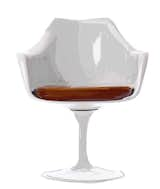The Story of Eero Saarinen’s Famous Tulip Chair
In 1922 at age 12, Eero Saarinen won his first design contest, illustrating a story entirely with matchsticks for a Swedish newspaper. The prize was 30 Swedish kronor (about $8 at the time). The Finnish-American architect grew up surrounded by design. His father, Eliel Saarinen, was a well-known architect and his mother, Loja Saarinen, was a talented sculptor and textile maker. By the time he was a teenager, Eero was designing furniture and fixtures with his father, who was president at the prestigious Cranbrook Academy of Art in Michigan.
In 1929, Eero left for Paris to study sculpture at the Académie de la Grande Chaumière and the following year enrolled in the Yale architecture program. In the ’30s, he followed in his father’s footsteps and joined the family firm, also returning to teach at Cranbrook, which is where he became friends with Florence Knoll and Charles Eames, who turned into formative collaborators.
Eero’s first major recognition for furniture design was for a molded plywood chair he designed with Eames for the Organic Design in Home Furnishings competition in the early ’40s. That same decade, he entered a long and fruitful design partnership with Knoll and submitted the winning design for the St. Louis Gateway Arch—even though the telegraph announcement, addressed to "E. Saarinen," was initially mistaken to be for his father, who’d also entered the national design competition. Still, while Eero’s architectural feats garnered serious recognition (and a spot on a July 1956 cover of Time magazine), his furniture ranks among the most celebrated of the 20th century.
Longtime friends and collaborators Florence Knoll and Eero Saarinen develop prototypes for the Pedestal Collection, which includes a dining chair, armchair, dining and coffee tables, and stools.
In the late ’50s, Eero designed the Pedestal Collection for Knoll to alleviate the visual clutter he famously hated in American homes caused by a jumble of furniture legs in one room. "The undercarriage of chairs and tables in a typical interior makes an ugly, confusing, unrestful world," he said. "I wanted to clear up the slum of legs."
The furniture series, which features a dining chair and an armchair, as well as dining, coffee, and side tables, and stools, trades the standard four legs of chairs and tables for one central tulip-like pedestal, hence the moniker. Saarinen’s intention to "make the chair all one thing again" extended to materials. He wanted to mold the Tulip chair from one material, but it was technologically impossible at the time. Instead, a reinforced aluminum stem with a fused plastic finish supports the curved fiberglass shell.
Eero included the Tulip chair in several of his projects, including the Miller House in Columbus, Indiana, and the TWA Terminal at New York’s Idlewild Airport (now John F. Kennedy International Airport). Architectural historian Jayne Merkel, who wrote the 2014 monograph Eero Saarinen, once said that "the TWA terminal is Saarinen’s pedestal chair turned into a building." The form draws on his early training as a sculptor.
Though the Pedestal Collection was Eero Saarinen’s last—the prolific modernist architect and industrial designer died of a brain tumor in 1961—thankfully, his sculptural nod to the future of design has lived on. His award-winning Tulip chair has become a symbol of 1950s style and the midcentury-modernist foreshadowing of space-age aesthetics. Real and knockoff versions of the Tulip chair have made frequent cameos on Star Trek sets and appeared more recently in blockbusters like Barbie.
Shop the Look
We love the products we feature and hope you do, too. If you buy something through a link on the site, we may earn an affiliate commission.
This article was originally published on January 28, 2015. It was updated on August 20, 2024, to include current information.
Top photo by Leslie Williamson
Published
Last Updated
Topics
LifestyleGet the Dwell Newsletter
Be the first to see our latest home tours, design news, and more.









